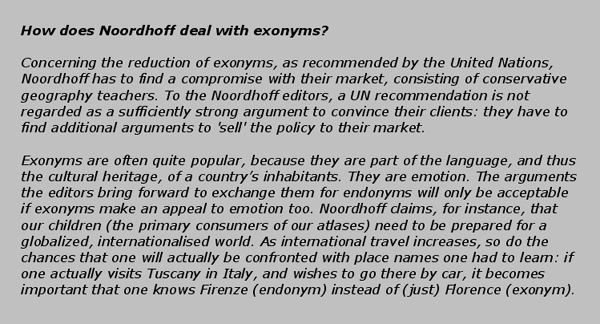|
|
|
|
1. Choices and constraints - A) Exonyms
|
|
|
Exonyms or endonyms?
The UN calls for a reduction of exonyms,
as their continued use hinders international communication.
The use of endonyms
(#076) only is propagated ("Local names Policy").
Advocates of the use of exonyms claim that names are easier
to learn or remember when adapted to one's own language, and
that it will be easier to connect objects outside one's country
to one's history if the relevant exonyms are used.
Nevertheless it should always be clear which names are exonyms
and which names are official local names (endonyms). That can
be ascertained for instance by always presenting the endonym
first. If there is no exonym, than the only name presented must
be an endonym.
For which names should we use
exonyms?
For most language areas lists have been produced that show the
exonyms that are still current for that language. Below an example
of a list of exonyms, provided by the Dutch
Language Union (Nederlandse Taalunie / look under "Buitenlandse aardrijkskundige namen" in the central column under "Taal") can be found. These
exonyms are in use wherever the Dutch language has offical status:
Aruba, Belgium (Flanders), Curacao, the Netherlands, St Maarten
and Suriname. The column "Dutch" has the Dutch exonyms,
the column "Local name " has the endonyms.

Guidelines can be given for the
use of exonyms, depending on the name category; for an English
school atlas, such guidelines entail the following (examples
of the resulting name versions in blue):
- Country names: exonyms
only (Hungary)
- Names of continents
or parts of continents: exonyms only (Asia)
- Town or city names:
endonyms (exonyms) Roma (Rome)
- Rivers: endonyms
(exonyms) Rhein (Rhine)
- Mountain names: endonyms
(exonyms) Matterhorn
- Names of (physical)
regions and islands: endonyms (exonyms) Sicilia
(Sicily)
- Sea names: exonyms
only: Mediterranean
But: keep the number of exonyms
added in brackets to the endonyms as small as possible.

|
  |
|
|
|
|
|
|
|

